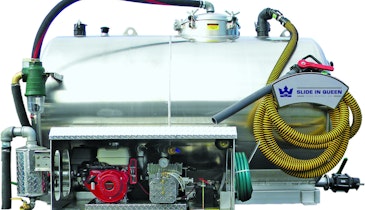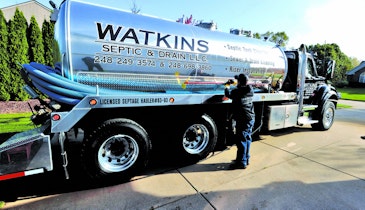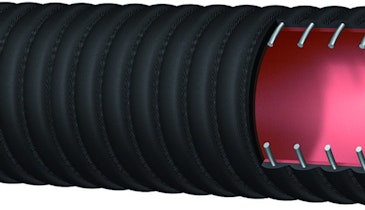The National Association of Wastewater Transporters doesn’t have the resources to become involved in every state and local legislative fight, but we want to respond to concerns arising from them. For example, Bart Clark, a professional engineer with Oakwood Environmental Associates in Warren, N.Y., sent a letter after the Department of Conservation updated some onsite regulations without notifying the stakeholders. Although annoyed by the omission, Clark’s key concern was that the new rules required counties to have management plans, yet set no standards or criteria for onsite inspections, and did not appoint anyone to do them. Clark felt the onsite industry wasn’t knowledgeable enough or prepared for the responsibility.
Using NAWT’s database, I relayed Clark’s concerns to 50 key people in the state. Many called or e-mailed him, providing information on NAWT’s training programs and state association certification courses. Later, Clark thanked me for getting the word out and putting the right people together.
A similar situation happened in Ohio. To set the stage, the Public Health Council adopted onsite rules that became effective on Jan. 1, 2007. A coalition of manufacturers from the onsite industry then petitioned legislators, claiming that the amended code was unfavorable to new technologies. They were correct. The House rescinded the bill in July, and created the Home Sewage and Small Flow On-site System Sewage Treatment System Study Commission to recommend efficient and effective ways to treat sewage. The commission’s report is due Dec. 31, 2008.
In September, 18th District Ohio State Sen. Timothy Grendell (R-Chesterland) wrote a memorandum to the commission. In it, he stated that periodical inspections are infeasible: Most local health districts don’t have the money or personnel to conduct them, third-party private companies are untrustworthy, and landowners can’t afford paying the salaries of newly hired field sanitarians or sophisticated, costly onsite systems.
In his letter, Grendell proposes allowing local health districts to establish their own rules. He believes that the cheapest system meeting minimum health standards is all that should be required, and that holding tanks are unnecessary. In short, the new technology is being pushed without any clear evidence that it is needed.
WHITE PAPER
In response to Grendell’s mindset, the NAWT Board of Directors composed the following White Paper:
Members of the National Association of Wastewater Transporters service septic or decentralized onsite wastewater treatment systems. NAWT’s mission is to represent these service providers on a national level and offer educational opportunities and credentialing. We are partners with the U.S. Environmental Protection Agency and 11 other national organizations in a Memorandum of Understanding that support onsite systems.
Our endorsement is well founded. In 1995, the U.S. Congress asked the EPA, “What are we going to do with all these septic systems? Do we need to sewer the country? All we hear are horror stories about failing systems.” After researching the facts, EPA responded to Congress in 1997. The report, Document 832R97001B, is at epa.gov. Here are its highlights:
1) Adequately managed decentralized wastewater systems are cost-effective, long-term options for meeting public health and water quality goals, particularly in less densely populated areas. Unlike past practices of installing onsite systems to serve until the sewers come, today’s technology can be installed almost anywhere. In addition, these systems help promote better watershed management by not transferring water from one watershed to another as is the practice of most municipal treatment plants.
2) Decentralized systems serve approximately 25 percent of the U.S. population, and approximately 37 percent of new development.
3) For communities with small populations, the most cost-effective option is often onsite decentralized systems. These systems are suitable for various site conditions including shallow water tables, bedrock, low-permeability soils, and small lots.
4) Onsite system expansion is inhibited by:
• Lack of knowledge and misperceptions by homeowners, service providers, and regulators.
• Absent, vague, or inapplicable state legislation and the splitting of state and local governments. Such actions create confusion over accountability and program coordination, giving centralized facilities the upper hand and denying onsite systems equal stature.
• Inflexible and prescriptive regulatory codes that often allow only conventional systems. Where alternative systems are approved, the permit process is often lengthy, resulting in the selection of inadequate onsite systems, needlessly expensive centralized systems, or their expansions.
5) Few communities have developed the necessary organizational structures to manage onsite systems. Without maintenance, they will fail to treat wastewater properly.
6) Homeowners and developers are often unwilling to accept the responsibility and potential liability associated with onsite systems.
7) The EPA’s Construction Grants program and the Clean Water State Revolving Fund program are the major sources of wastewater treatment facility funding, but they are generally available only to public entities. Federal and state grant and loan programs make it difficult for privately owned systems to obtain these funds.
SOLVING THE PROBLEM
Working with MOU partners, NAWT provides education to homeowners and industry participants. Our nationally acclaimed programs cover onsite installation, operation and maintenance, inspections for real estate transactions, vacuum truck technician training, and waste treatment training. We have certified more than 3,000 members.
NAWT believes that good management begins with understanding how system components work, how they are installed, and how they are maintained. Arizona, New Mexico, and Delaware have made NAWT training part of their onsite management requirements, and California, Texas, Michigan, and Massachusetts have recognized it as an integral part of their continuing education programs. NAWT cooperates with Florida and Minnesota and their longstanding education programs, and provides courses in Ohio through the Ohio Waste Haulers Association. NAWT partners with other national and regional organizations to offer the best training programs possible, while fulfilling its core responsibilities to pumpers and maintenance providers.
Unfortunately, participation in these courses is still directly proportional to regulatory requirements in many states. Counties in Colorado and New Mexico, however, took the lead and required NAWT certifications before the states adopted the requirements.
Arizona is an example of a state with a successful regulated program. Its Department of Environmental Quality requires training and certification for individuals inspecting onsite systems for real estate transactions. A strict reporting requirement enables the state to populate its database with systems installed before 2001, when records were lacking. Regulators are using issues that become apparent through inspections to further refine state code.
In conclusion, Ohio is not alone in its efforts to manage and upgrade many existing onsite systems. One by one, each state is working on pieces of the solution. In most cases, the status quo is unacceptable. A management program for all onsite systems is a necessity. NAWT believes that states must pass strong regulations based on sound science, then authorize counties to enact them. Low interest funding is needed to help property owners implement repairs, and the education of homeowners, service providers, installers, inspectors, regulators, and every segment of the industry is imperative!
***
If you see similar legislative activities happening in your state, get NAWT involved. We can make a difference. Call 800/236-6298 or visit www.nawt.org.





